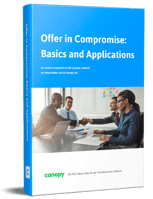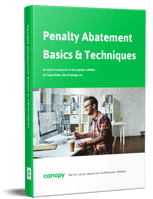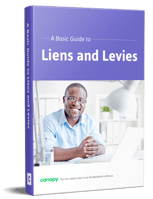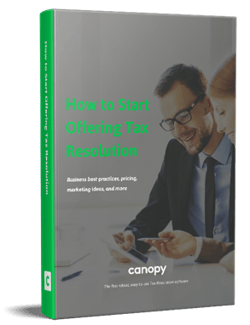In the past, it was difficult to get into tax resolution. You pretty much had to be an expert of the intimidatingly thick IRS manual. However, now that tax resolution services are growing in popularity, there are tons of resources available that make breaking into the business easier than ever.
What is tax resolution?
Tax resolution includes many services and goes by different names (IRS representation, tax relief, tax problem recovery, tax resolution, tax controversy) but in summary, tax resolution is a service in which you help a client resolve their open debt with the IRS in a way that minimizes the debt as much as possible.
Tax resolution services include:
- Offer in Compromise
- Installment Agreement
- Penalty Abatement
- Innocent Spouse
- Audit Representation
- Liens
- Levies
- Trust Fund Recovery
More and more tax professionals are offering tax resolution as a way to supplement tax preparation work because tax resolution cases can be extremely lucrative, and they have more flexibility in deadlines with the IRS, making it a great service to offer year-round, not just during tax season.
How do I qualify to offer tax resolution?
In order to qualify to offer tax resolution, you must be an Enrolled Agent, CPA, or tax attorney.
To become an EA, you can take one of two paths.
The first option is:
- Obtain a Personal Tax Identification Number (PTIN)
- Take the Special Enrollment Examination (SEE). Here you can find examples of past examinations and answers, provided by the IRS
- Pass all sections of the SEE
- Apply for enrollment on Form 23
- Pass a background check, which will include a review of your tax transcript
The second option is:
- Have the required experience working with the IRS, as specified in section 10.4 of Circular 230
- Apply for enrollment on Form 23
- Pass the background check
To become a CPA you must do the following:
- Earn 150 credit hours of education
- Pass all four sections of the CPA Exam
- Meet work experience requirements for the state you live in
Once you’ve become certified as an EA, CPA, or tax attorney, you should obtain a Centralized Authorization File (CAF) number. A CAF is a nine-digit number assigned to you by the IRS that they use to track your requests for client information, such as transcripts.
To obtain a CAF number, write “none” in the space designated for a CAF the first time you file a Power of Attorney (Form 2848) of Tax Information Authorization (Form 8821). The IRS will send you a letter with your CAF number and you’ll use that number for each case going forward.
Where can I learn tax resolution?
One of the most helpful things you can do to learn tax resolution is to take a course or attend a webinar taught by professionals in the field. The good news is, you have options.
Canopy offers high-quality tax resolution CPE courses taught by qualified and respected instructors like Tanya Baber and TaxMama®. The courses cover a range of topics, from how to get started as an EA and basic tax resolution tips and tricks, to advanced technical courses on Penalty Abatement and Offer in Compromise.
In addition, the National Association of Enrolled Agents (NAEA) offers various resources for continuing your education in tax resolution including webinars and a schedule of conferences to attend. Groups like the ASTPS also offers Tax Resolution Boot Camp if you prefer learning in-person.
How do I set myself apart as a tax resolution expert?
To further your qualifications in tax resolution you can become a Certified Tax Resolution Specialist (CTRS). Certified Tax Resolution Specialists are often identified as experts in the industry. If that’s the route you’re looking to take, here’s a brief summary of requirements (as outlined by the ASTPS):
- You must be an EA, CPA, or attorney
- Submit an Application for Examination reflecting your eligibility
- Pay exam fee
- Complete exam and return within 30 days. The test consists of 150 questions covering IRS Problem Resolution and a comprehensive case problem. You must score at least 75% on each section to pass.
- Sign an agreement to abide by rules and code of ethics
Here you can find the ASTPS Certification Program in more detail.
Where can I find help with tax resolution?
After you’ve gained a good foundation of what tax resolution entails and you start practicing tax resolution, there are more resources out there designed to help you do the actual tax resolution work — you’re not left on your own.
For starters, Canopy has an entire library of ebooks that cover subjects such as Offer in Compromise, liens and levies, and Penalty Abatement.
If you’d like tips on Tax Resolution strategies, read books like Jassen Bowman’s Tax Resolution Secrets, available as an ebook or hard copy. The book includes instructions for how to employ proven methods of tax resolution.
Another helpful resource is modern tax resolution software. For example, if you use Canopy, there’s no need for you to memorize every complicated IRS code, because the software will automate data gathering, auto-populate the appropriate IRS forms for your clients’ cases, solve collection cases, and more. Canopy can save you 5-10 hours per case. With the help of Canopy, you could start offering tax resolution today, growing your practice, client base, and income.
If you want to read more about how to start offering tax resolution services, check out our free ebook. You’ll learn more about adding tax resolution services to your practice, pricing those services, and more.












Get Our Latest Updates and News by Subscribing.
Join our email list for offers, and industry leading articles and content.